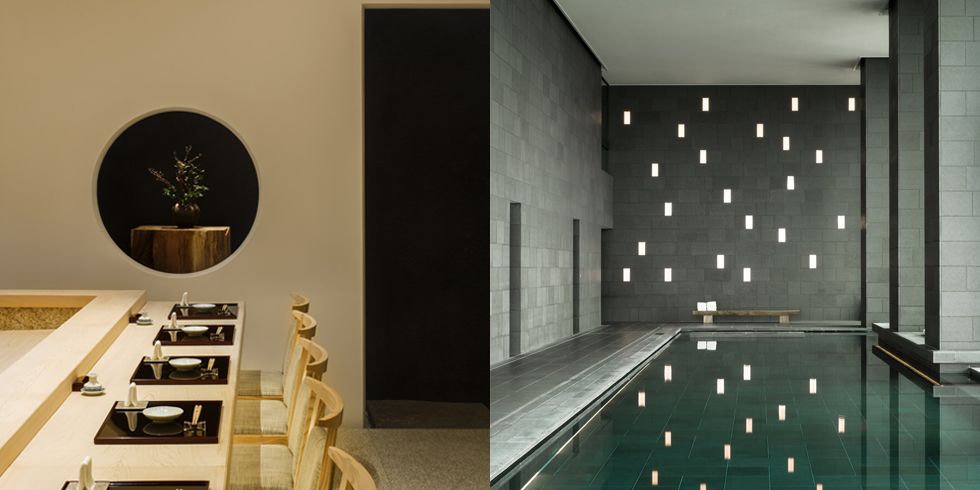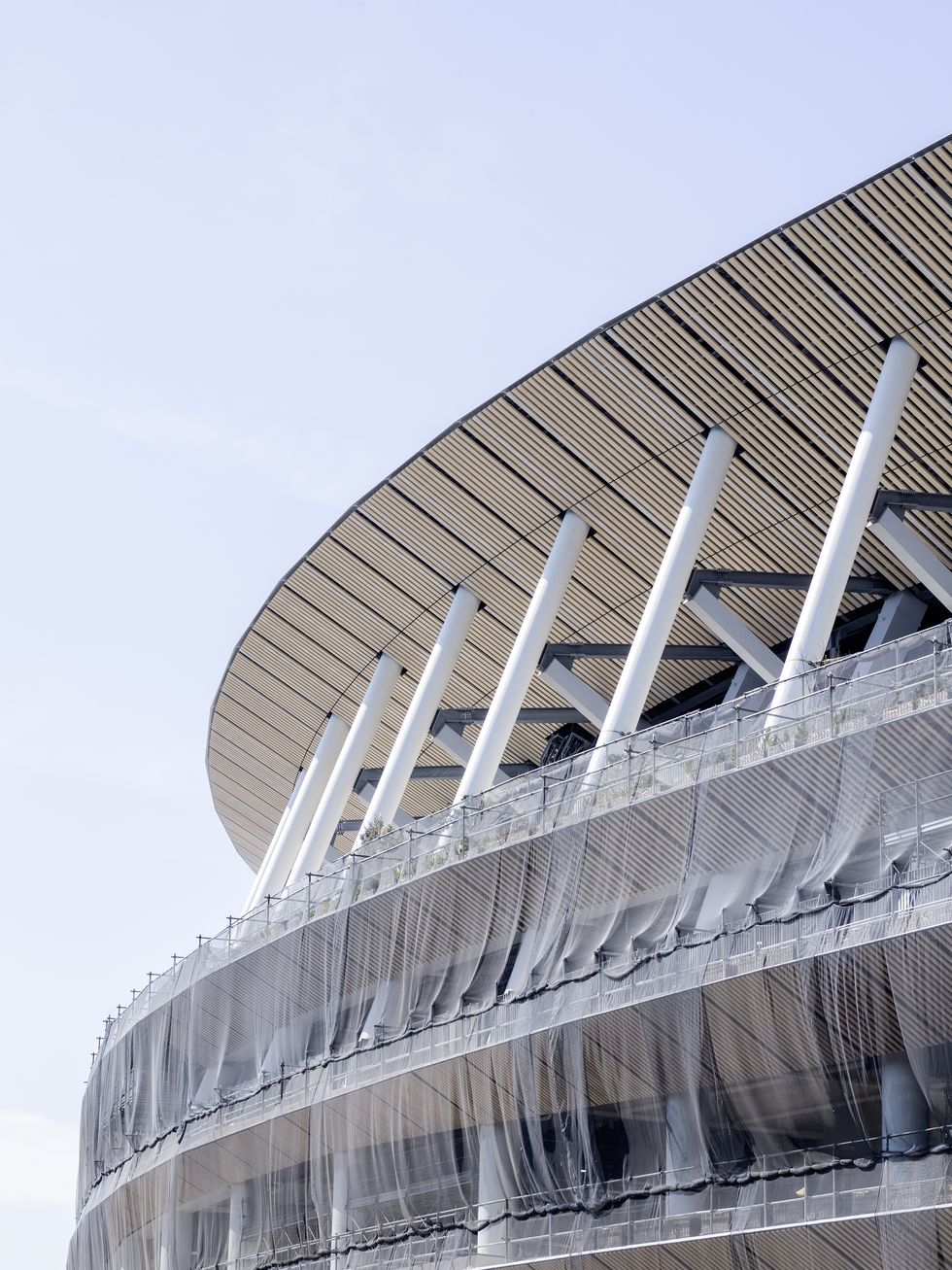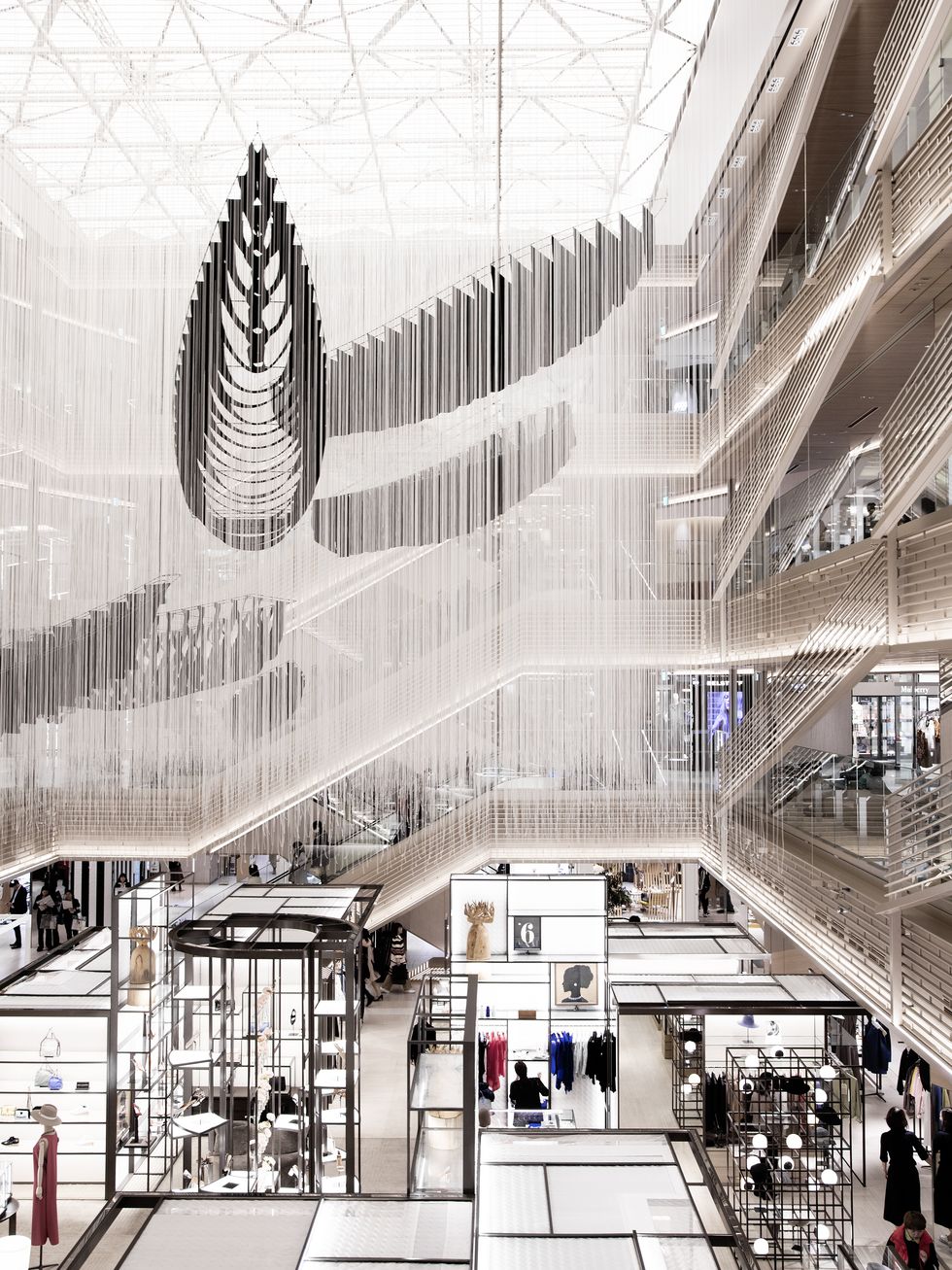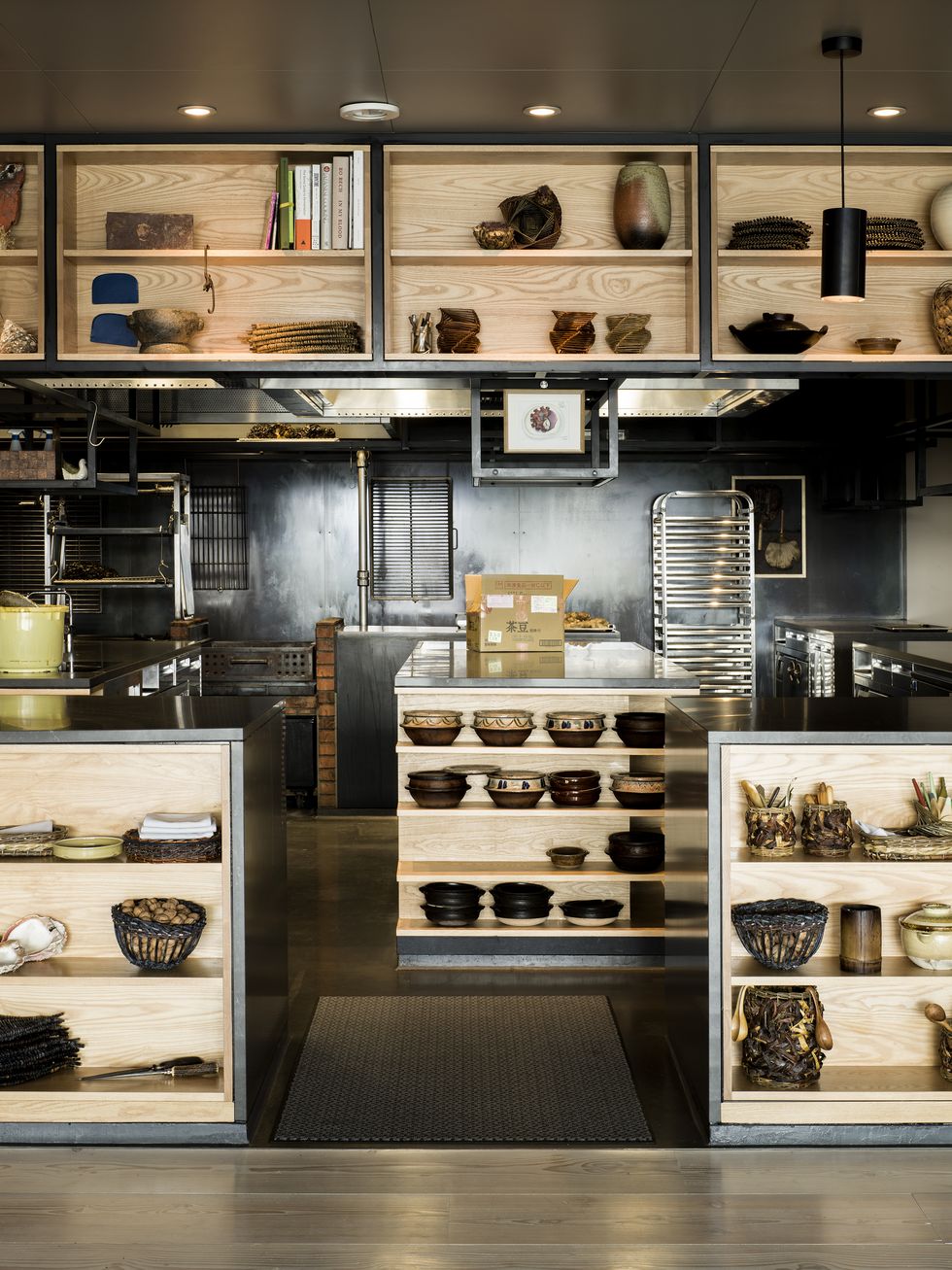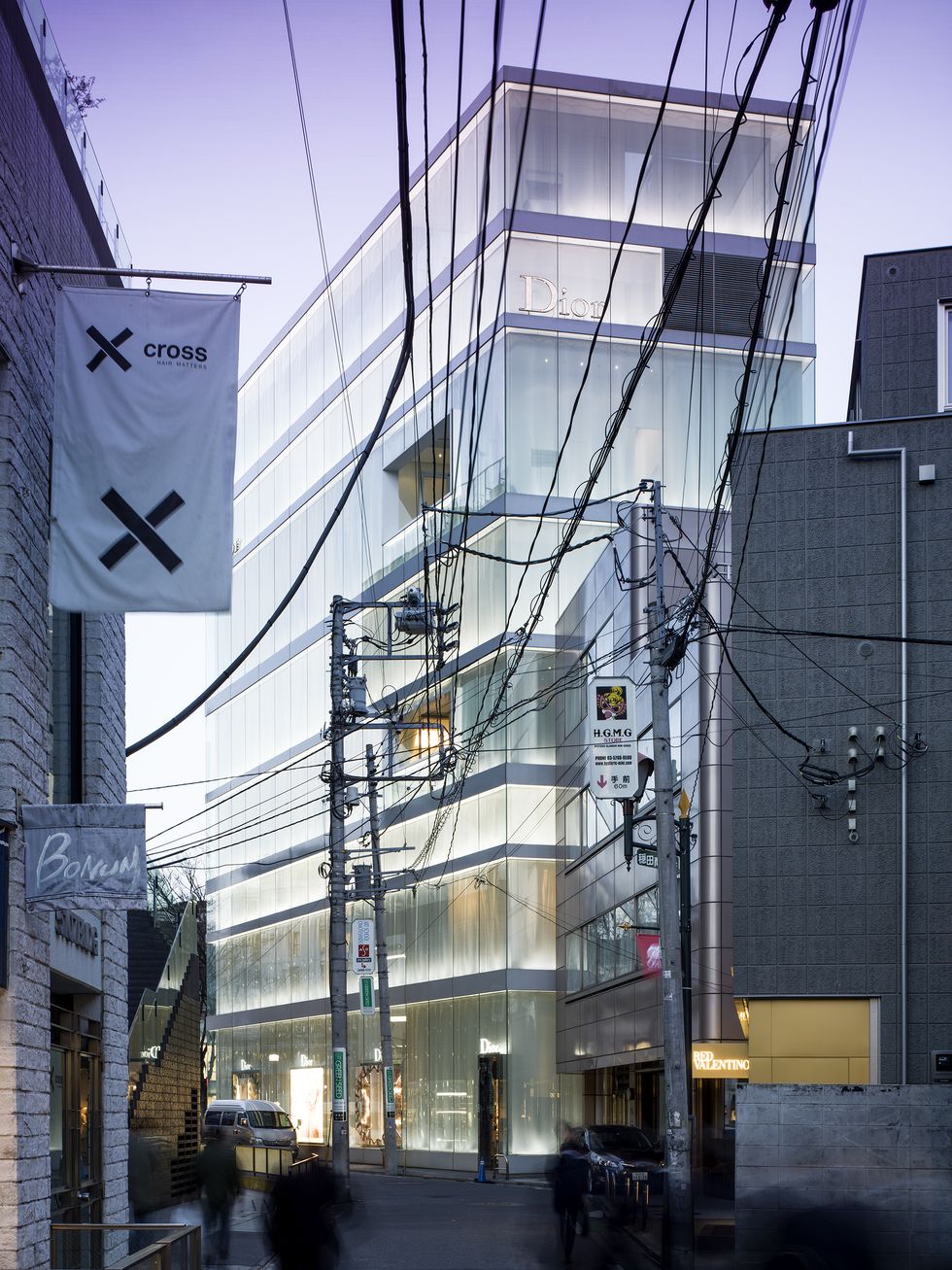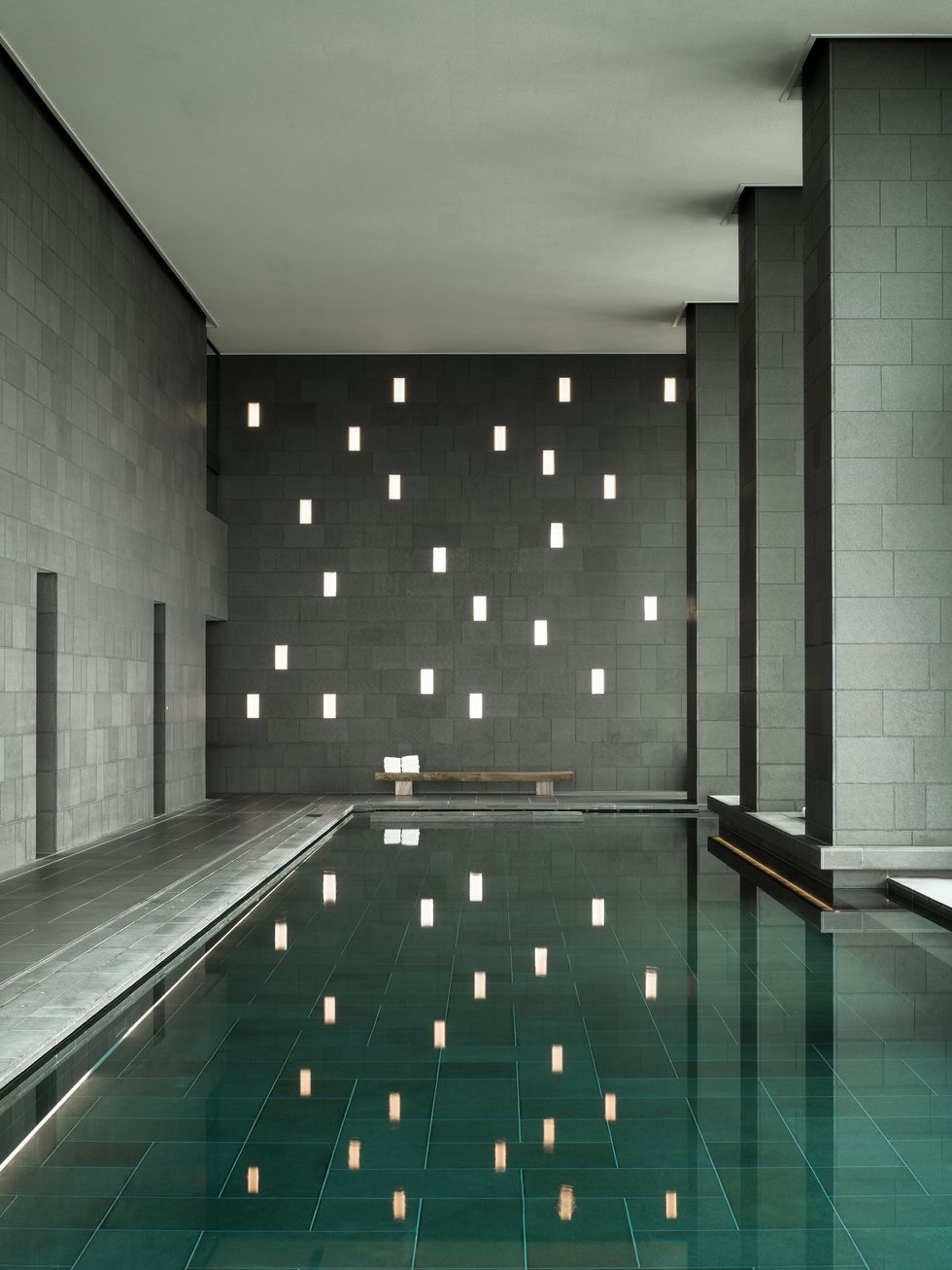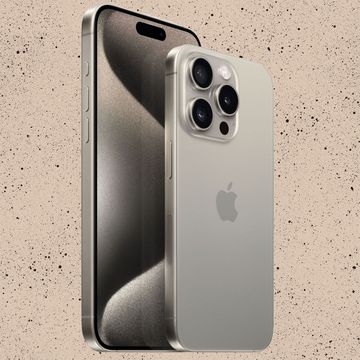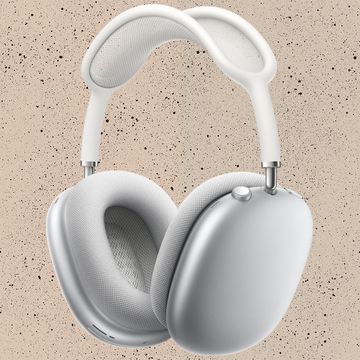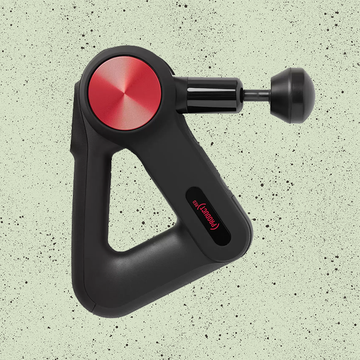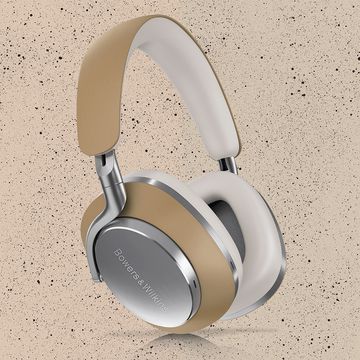When punishment came it was swift; the embarrassment acute. The blame all mine. I had picked up my cuttlefish using the tips of my chopsticks, not the sides. Had I studied my 96-page restaurant guidebook, Sushi: Jiro Gastronomy, available at the reception desk of this eight-seater, two-Michelin-starred restaurant, as well as bookshops across Tokyo, more closely, I would not have been so foolish. “Think of the sushi as a portable shrine,” it advises. “Place your chopsticks parallel to the tray as if they are the shrine’s carrying poles, and lift the sushi by grasping it along its sides.”
Had I done so, the sushi would not have buckled as I lifted it on its journey, that terrifying journey, to my mouth from the counter tray, where Chef Takashi Ono’s apprentice had placed it moments before. (That abyss was a feeble 138cm, or three times the length of a certain kind of chopstick, deemed the correct distance to promote a congenial atmosphere between sushi chef and customer.) Ono would not have needed to cry out. He would not have had to strike his apprentice on the shoulder, hard. He would not have had to grab that sushi back and remake it more robustly, himself. And the maître’d would not have had to hurry to my seat to spirit away the two or three pieces of rice that had fallen to the bar, a sign to everyone that — adopt the brace position — total sushi collapse may have been imminent.
The apprentice was reprimanded, I was quietly told later, because he should have placed the fish at a slightly more side-facing angle, to assist my collection. But I wasn’t buying that. I’d come here expecting rules. I’d seen Jiro Dreams Of Sushi, the Netflix documentary about the world’s greatest sushi chef, Jiro Ono, now 93-years-old, and his two sons, Yoshikazu, 57, and Takashi, 53, who strive to live up to his standards. Don’t bite your sushi, don’t leave it on the plate (eat it immediately), don’t share it with a friend, don’t peel the topping, don’t get up to use the bathroom, don’t go expecting a menu (there isn’t one) and under no circumstances add extra soy sauce. Preparation is executed to military precision and customers have been scolded for such I-reckon-this-could-do-with-a-bit-more-flavour idiocy before. At £260 for 20 pieces of sushi, you’re a long way from Itsu. You are in the hands of an artisan.
Ono pays attention to whether customers are left- or right-handed and alters the depth of sushi based on their gender. At six centimetres, aji sushi is designed to be consumed in one mouthful. And this was sushi like silk: exquisite saba (mackerel), heavenly hirame (halibut), mind-blowing octopus; an hour-long taste symphony with a clear progression from start to finish. I was in Roppongi Hills, Tokyo, the second Jiro outpost, run by Takashi Ono in a mirror image of his father’s restaurant in Ginza. There are two sittings, 11.30am and 5.30pm. After cleaning their kitchens for the following morning, the chefs are home by 1am to rise again at 5am, for Tokyo’s Tsukiji Market, the largest fish market in the world.
“We work so hard so we have no time to learn English,” Takashi Ono chuckles, though it sounded fairly impeccable to me. Instead, he says, he’s learned to say “thank you” in 40 languages. Since the Netflix documentary, the Ono fanbase has become considerably more international. “Am I pleased about that? Oh yes.”
This was not my first meal when I arrived Tokyo. That took place down some steps in an alley, near my hotel in Shinjuku, the business district, housing the northern half of the world’s busiest railway station, in the biggest city in the world, surrounded by whisky bars and burlesque clubs. I was just off a 7am flight and hungry: a noodle bar was calling.
Order by punching buttons on a vending machine outside, find a booth downstairs, select richness of flavour, spiciness of sauce and texture of ramen by circling drawings on a bingo-style card, and your steaming bespoke bowl is presented under a wicker curtain by a waitress whose face you never see. Slurped down with an Asahi or two, and for ¥2,000 (£13), it may have been the most delicious meal I’ve had in my life (apologies Takashi). But then all food in Tokyo is delicious.
The concept of “Ichi-go ichi-e” translates as “one time, one meeting” or “once in a lifetime”. Customer service here is an art form applicable to the wrapping of shop-bought gifts to the navigating of the (eminently negotiable, speedy, spotless, safe, punctual) Tokyo Metro. Pause at a map for a few moments to check your journey and someone really will appear to make sure you’re not lost. A bartender preparing a martini, a beer or a glass of water will do so in the exact same way. That is to say, with the same attention to detail. Every streetlight shines with identical brightness and strength as the others, giving the city its hyper-real beauty and depth. You’ll never see a department store employee taking an escalator, because those are for the customers.
“We have 30 employees and currently three of those are dedicated to research,” says Thomas Frebel, who heads Inua, an offshoot of René Redzepi’s Noma restaurant that arrived in Tokyo from Denmark last year and began scooping up prizes immediately. “Because Japan is very long and thin, seasonality travels extremely fast. Take apples: they might only have one or two weeks in high season so those people need to be able to travel from farms from north to south, or south to north, depending on what season we are going for, if we are able to maintain a dish for six to eight weeks.”
Inua occupies the ninth floor of a building in the Iidabashi neighbourhood. An Inuit term for the “life force that runs through nature”, Inua serves seasonal Japanese dishes using ingredients sourced uniquely from the country’s land (not just apples, but kihada berries from Nagano and scarlet pitanga fruits from Okinawa). It has been a huge hit here. Could Frebel have foreseen that five years ago?
“No,” he says. “The way Japan has opened up in the last few years, people have started travelling here but also Japan has started travelling outside, and that has helped the world of gastronomy to be more open-minded. Now, what is happening next year with the Olympics coming to Tokyo, people are forced to open up more. At one point Tokyo was extremely difficult to approach. It was a closed society.”
Perhaps that’s what gave Tokyo its allure to the West. From the Eighties to the Noughties, Tokyo and Japan were Lucky Catnip to style magazines like this one. “Japan into the Future” suggested The Face in March 1987, its cover featuring a schoolboy wearing two sets of fluffy day-glo headphones, a backpack and the cover line “What is the Use of Minimalism?”. Jonathan Ross managed to extend his 2002 BBC TV show Japanorama into three (three!) six-part series that ran for five years, presenting each episode in a different Manga-coloured suit and tackling subjects from Astro Boy anime to a man who dressed in secondhand ANA air hostess uniforms, with a mixture of admiration and mirth.
Paul Smith was always on about the place, selling Tokyo-imported boomboxes and light-up robots alongside flowery shirts in his Floral Street London shop. The city was home to inspiration galore — eclectic street style subcultures, unparalleled artisanship and icons of design and architecture — things that made it a mecca for creatives of all persuasions. In an essay for The New Yorker last year, writer Matt Alt evoked a William Gibson quote from 2001: “‘Japan is the global imagination’s default setting for the future… the Japanese seem to the rest of us to live several measurable clicks down the time line’. Gibson was referring to a Japan of trendy gadgets and services, such as high-tech cell phones and robot sushi bars, the flashy products of a hyper- consumer metropolis that inspired the creators of such films as Blade Runner and The Matrix.”
Then there is all the culture Tokyo has given us in the last couple of decades. Akira and Toho Studios. Comme des Garçons and Sk8thing. Yukio Mishima and Yohji Yamamoto. Pokémon and Doraemon. Studio Ghibli and “Beat” Takeshi Kitano. Between 1990 and 2000, Japanese cultural exports doubled. Japanese film-makers, video artists and commercial directors were forever being hired, or copied, by Western producers. That White Stripes’ “The Hardest Button to Button” video featuring multiplying Jack and Meg Whites, directed by Michel Gondry, is great, isn’t it? But you might want to reappraise it after you’ve seen pop videos by Japanese director Nagi Noda.
It was after WWII when Japan’s economy truly began to flourish. America installed a government that worked with the nation’s industry to make it happen. Japan was able to pump out TVs, VCRs, camcorders and cars faster but also better than anyone else. By the Seventies, Sony, Sharp, Seiko, Panasonic, Toyota, Mitsubishi, TDK, Subaru, JVC, Fujifilm and Nikon were all barnstorming global brands. Other governments held talks about the “Japanization” of their countries. Harvard University social sciences professors plotted out the scenario of how a tiny island with no natural resources could soon end up dominating the economies of Britain and America.
Then it all went wrong. More recent years have been known as Japan’s “Lost Decade”, originally referring to the period from 1991 to 2000, but with the economy stagnant, extended to include the next decade too, up to 2010. As William Pesek says in his 2014 book Japanization, the word now took on a new meaning. A prototype for how not to behave in a post-economic crash world: “This noxious mix of trifling growth, high debt, falling consumer prices, waning confidence, and political dysfunction, has come to be known as ‘Japanization’”. In one of his early addresses, Barack Obama cited Japan’s Lost Decade as something his presidency would seek to avoid. Unsurprisingly, perhaps, since 1990 Japan has had 15 prime ministers.
Now Japan’s closed society worked against it. Unwilling to update its business and political systems, it was outmanoeuvred by its Asian neighbours. “Globalisation is causing a commoditisation of things Japan long did well,” writes Pesek. “Now, good cars and electronics are coming from virtually anywhere, including China. The only way Japan can thrive is to innovate as rarely before. What Japan lacks is a bunch of sleep-deprived, caffeine-driven Steve Jobs wannabes… creating game- changing products and new industries”.
Japan made amazing hardwear: great for the analogue age. Then Apple killed the CD. But even as the world went digital it was still years ahead of the West: in the Noughties, Japan was making phones that could send emails, make payments, access the internet and TV. With its population of 126m gadget-hungry consumers it saw little point in making this tech available to anybody else, locking itself into its own networks and operating systems. Finnish and Korean phone companies, with much smaller domestic markets, saw things differently. Korea’s Samsung, with its amazing suite of Galaxy products, is the largest tech company in the world after Apple. Sometimes Japan seemed to revel in this falling- behind status. In 2010, Sharp released a line of tablet computers called “Galapágos”: as in, the islands Charles Darwin explored, cut off from society. In 2011, Japan was absent from Forbes magazine’s annual ranking of the top “Fab 50 Asian companies” for the first time. That was also the year of the Fukushima Daiichi nuclear disaster, after which tourism rapidly shrank.
Losing out on tablet sales is one thing, losing your cool, your kakkoiī, quite another. Hong Kong has Art Basel, Seoul has clubs and superstar DJs. J-pop once threatened the world but along came K-pop with South Korea’s Psy and “Gangnam Style”. In 2012, K-pop group Girls’ Generation received the ultimate cultural accolade: a 7,000-word New Yorker profile. A year later, the state-backed Cool Japan Fund Inc launched, just about the least cool thing a country can do, that saw a teenage schoolgirl in a miniskirt sent abroad on a mission to enhance its international profile. Never mind that at 19, actress Shizuka Fujioka was no longer at school. The plan was to capitalise on Japan’s enduring craze for all things cute. Instead it came across as creepy.
As recently as 2017, in a small but significant publishing development, the globally influential Tokyo street style magazine Fruits closed after 20 years and 233 issues. This had nothing to do with the so-called “death of print” much lamented here in the West; Tokyo has a rich print market where the micro demographic is king. (Tokyo loves well-designed things you can hold in your hands.) It was sadder than that. “There are no more cool kids to photograph,” said Fruits’ founder Shoichi Aoki. Had the unthinkable happened? Had Tokyo stopped being cool? It certainly still claimed influence.
Wes Anderson’s recent movie Isle of Dogs was as much a love haiku to Tokyo as Tarantino’s Kill Bill films were 15 years earlier. There are fashion labels like Visvim, Cav Empt and Snow Peak. Kanye West’s love-in with the artist Takashi Murakami. The minimalist utilitarianism of Muji and Uniqlo. Marie bloody Kondo. But there is also a sense the attention of the world had turned elsewhere. Or maybe it has just grown too comfortable with what Tokyo had to offer. Like Jonathan Ross says in an episode of Japanorama: “After all, they were into Japanese food way before the rest of us got into it”.
“All of us now spend huge amounts of time… sitting in front of screens, rummaging through our own pop-culture databases, obsessing over our virtual identities while indulging in our own childlike pleasures, which range from the [Noughties] fad for cupcakes to cosplay or the latest Marvel superhero flick,” writes Matt Alt. “Japan was simply ahead of the curve.”
Except now our eyes are turning back. The Economist reports more people visited Tokyo in the first four months of 2018 than all of 2013. Annual arrivals to Japan have soared by more than 20m, making the country this decade’s fastest-growing major destination, in part due to relaxing visas for visitors from Thailand, Malaysia and Indonesia. Since 2015, Japan has slowly eased restrictions for Chinese citizens, too. Tokyo is the city with the most Michelin-starred restaurants in the world (and its food was awarded “Intangible Cultural Heritage” status by Unesco in 2013).
The city hosts the Rugby World Cup in September, while the 2020 Olympics will amalgamate Tokyo’s past and future, revamping some of the country’s most iconic mid-century buildings, and unveiling new launches by architects such as Kengo Kuma, Tadao Ando and Schemata. Taxi firms are recruiting more English-speaking drivers. Louis Vuitton references Japanese iconography and public service uniforms in its current men’s collection. And no joke, the latest thing in interior design is “Japandi”, a portmanteau of Japanese and Scandi; clean lines and minimal spaces showcased everywhere from iittala to Ikea.
“The Olympics is a big opportunity for Tokyo,” says its stadium’s architect Kengo Kuma, when I visit him at his office, sat amid its sliding shelves of floor-to-ceiling reference books. Kuma, an ageless 64-year-old in buttoned-up greys, is responsible for some of the city’s (and the world’s) most acclaimed projects, often favouring natural materials. His work in Tokyo includes The Suntory Museum of Art, the Food and Agricultural Museum and a truly insane cake shop in Minami-Aoyama.
“The first Olympics we had in 1964, I was 10.I remember it very clearly,” he says. “It was a kind of peak of economic expansion and of industrialisation for Japan. We had many huge projects: bullet trains, big hotel projects, freeways. The 1964 Olympics became a symbol where we got to present all that to the world.”
The 2020 stadium (officially the New National Stadium) was to be built by the late Zaha Hadid, whose £1.3bn design resembled a giganticStar Trek villain’s space palace and attracted abhorration from Tokyo’s architectural community, before being scrapped by the prime ministerin an almighty row over escalating costs.
“My construction is very different,” Kuma says. “We tried to drop the height as much as possible to be level with the ground. The structure of the roof has been minimised as much as possible. The scheme by Zaha Hadid was 75m high to the top of the building, mine is 49m. Also, the location is very unique for an Olympic Stadium because it is in the Meiji Jingu Gaien forest. I tried to curate a very peaceful natural building instead of a practical sports building; something that gives up a very soft atmosphere.
“Construction is 70 per cent done,” he beams. “We will finish in November this year.”
Japanese architects are the most audacious and inventive in the world. Yet Tokyo is famous for being a city of contradictions. Kuma’s uniting of old and new is very Tokyo. “In the 19th century, especially in Tokyo, things were made of wood, paper, and ceramic tiles; these three materials,” he says. “I want to bring this huge city back to that kind of intimacy. I think it is possible.”
The next morning, I visit Kuma’s stadium. Half-covered by tarpaulins and surrounded by construction workers in uniforms shamelessly stolen from the Beastie Boys’ “Intergalactic” video, it is nevertheless a sight to behold: a latticed timber oval with a huge oculus visible above the track, using natural wood extracted from Japan’s forests as its primary material.
Nearby, in the atrium of an 18-storey office block, artist Akira Fujimoto and architect Yoko Nagayama have placed a 7m silver sphere, functioning as the zero in the number “2021” — a work they hope will encourage visitors to look beyond the 2020 Olympics, to Tokyo’s future.
Fashion, of course, always looks to the future. The “Valentino TKY” show opened a new Ginza Six store and cited two Japanese aesthetics for inspiration: wabi-sabi, the idea of beauty in imperfection, and the ma, or invisible space. Dior, in comparison, mined its womenswear archives for Japanese influences to reinterpret as men’s garments, and opened an SS ’19 menswear pop-up shop. Its creative director Kim Jones pointed to Christian Dior’s love of Japan and its synergy with his own fascination with travel and the country. Both Dior and Valentino staged pre-AW ’19 runway shows here, while Giorgio Armani announced it will stage its first Tokyo resort runway show in May to coincide with the reopening of the brand’s Ginza flagship. Tokyo may be the spiritual home of cutting-edge men’s style, not least its deep and innovative streetwear scene, its fascination with limited editions and its status as the capital of “drop” culture, but the decisions for brands to focus their attention on the city are likely much more than a hat-tip to those ideas.
“They are trying to engage with the Japanese, also knowing that by doing so they will capture the Chinese client,” says Shoichi Tamai, brand director of online fashion retailer Farfetch, when we meet in his offices near the Imperial Palace. “By using Tokyo they can get a bigger audience from China and Korea. The rich Chinese love Japan. It’s like the British making money from Middle Easterners.”
He points to a designer brand that recently launched a series of collaborations, each clearly targeting a specific demographic. One tie-in was with a Tokyo DJ and street style scenester, someone, Tamai believes, chosen not because he was super-hot but almost the opposite: his credibility had already peaked. “It didn’t go down well with locals, it’s for the Chinese,” he says. “To the Japanese he is like David Beckham in the UK, sorry to say, but many more times worse.”
With China expected to account for half of all luxury sales by 2025, Japanese consumers may no longer be the object of affection and attention to the degree they once were. But Tokyo remains one of the most attractive destinations for other Asians. What’s more, physical retail is still huge in Tokyo; department stores remain the dominant luxury distributors. This is a place where you can still shift a lot of clothes.
“Japan is an important market for us and on top it’s a hub for all Asia,” Pietro Beccari, chairman and CEO of Christian Dior Couture told The Business of Fashion. “Lots of Chinese are travelling there, Tokyo is preparing for the Olympics, it’s a vibrant city, more so now the economy is doing well, so that’s why I was happy to go along with [Kim Jones’] proposition.”
Akiko Shinoda is director of international relations for Amazon Fashion Week Tokyo. In 2009, she convinced Japan’s government to sponsor a showcase of young Japanese fashion talent in New York. Having watched Korea, Indonesia and Singapore invest heavily in fashion, she finds it ironic Tokyo is only now seeing its own potential. “This story has a long history and we have worked very hard to get our government to put in money,” Shinoda tells me. “Previously, fashion week was done by the designers themselves, nobody tried to organise it, or to promote it. But now at last they understand that Tokyo has a very big connection with people, particularly fashion people.”
A stroll down omotesandō, the tree-lined avenue in Shibuya, confirms this. It surely represents the coolest collection of buildings anywhere in the world: remarkable space-age architectural triumphs, fashion flagships for Gucci, Louis Vuitton, Dior, Coach. From the glass bubble-esque façade of the Herzog & de Meuron-designed Prada building to the minimalist tree-inspired form of the Tod’s tower by Toyo Ito.
Bottega Veneta opened its six-floor flagship store in Ginza, Tokyo’s other luxury shopping mecca, last December. It’s the brand’s biggest Asian store. I marvel at the exterior with its 900-plus square metal panels, its façade echoing the brand’s trademark leather weave, and the interior with its folding planes created in “Kyoto white” plaster. I’m shown a rainbow selection of wallets and card carriers, the brand’s top sellers for men.
“I find Tokyo to be a truly remarkable city,” says Giorgio Armani, via email. “Capable of reaching forward into the future while remaining faithful to its past, fully respecting the country’s deeply rooted traditions. It is very interesting to witness how seamlessly the modern coexists with the ancient, devoid of any apparent contradiction. A favourite memory is from 1998, presenting my collections in front of the Seitoku Kinen Kaigakan [Meiji Memorial Picture Gallery], when an art critic and the curator of an important museum defined my fashion as being ‘iki’, meaning ‘abstract seduction’. I found it a unique way to describe my style.”
This spring the Armani Ginza Tower reopens, on the site of the existing one: a vast glass structure amid metal-covered, golden-coated, LED-backlit bamboo trees.
“I opened the Armani/Ginza Tower in 2007 as part of the new concept stores I was exploring,” Armani says. “A place where many of my brands could exist, side by side, a reflection of how shopping was changing. Since then it has become one of the most important architectural landmarks in the area. Now it’s reopening with a new look. I worked on the restyling project, in collaboration with my architects. I chose to express a desire for renewal, with the utmost respect for Japanese culture and its values.”
While Omotesandō and Ginza get to show off the big guns, there is equal joy to be found in backstreet shops. In Nakameguro, the seasoned hipster area, I found the record shop Waltz, selling music old and new on cassette. In Daikanyama, I visited Tsutaya Books, a two- storey building where more than 140,000 books and magazines line the walls and sit on display tables. The store also manages to encompass a toy shop, a dog-grooming and pet-hotel facility, an electric-bike shop, a convenience store, a speciality camera shop, a restaurant and a café.
In Shibuya there’s the tiny Loopwheeler selling perfect sweatshirts handmade on a 20th-century machine by founder Satoshi Suzuki. I also loved Pass the Baton, with its branches in Marunouchi Brick Square and Omotesandō, which sells pre-owned clothes and accessories, many clearly by people in the fashion industry.
“There are so many small, good brands here, in the backstreets of Omotesandō or Shibuya,” says Shoichi Tamai. “The challenge for Tokyo is establishing brands which are big enough to export, when they’re not backed by big capital like [luxury conglomerates] LVMH or Kering. At the same time, in Tokyo and Japan we have a word ‘tsutsumashīdesu’, ‘humble’. Historically, we like to be seen as simple, not too showy.”
In other words, sometimes small is big enough. This may seem an odd idea for the city that gave us outrageously OTT street styles like Gothic Lolitas, the custom-bike obsessed Bōsōzoku, or the Harajuku Girls. But, as discussed, Tokyo is a place of paradoxes: where individualism is praised but the uniform is king, where they like their wine hot but their fish cold. And to the Fruits founder’s point, I didn’t see anyone who might be classified as a “Harajuku Girl” in my time here. Even in Harajuku.
“That was over before Gwen Stefani made that record,” someone tuts, when I bring it up.
After I’d had enough of window shopping, I jump on the Metro and head to Odaiba, the artificial island in Tokyo Bay. This high-tech hub is the place to interact with robots at the Miraikan science museum, Instagram Mount Fuji from the top of the 115m Daikanransha ferris wheel or kick stones along the man-made beach at Seaside Park, gazing back at the metropolis. Instead I purchase a ticket to Aomi Station.
Inside is a 10,000sq m box the Tokyo art collective teamLab bill as the first digital art museum. Using 520 computers and 470 projectors, teamLab Borderless is a cavern of connected rooms filled with amazing, beautiful, immersive neon artworks that swim before your eyes: an infinite space full of LED mirrors, a forest of lamps that switch colour as you near them, a “Flower Forest” room where walls and floors are covered in blooms. Touching flowers causes them to wilt; tap a passing butterfly and it dies, only to pop up, reborn somewhere else. I wander dumbfounded under cascading waterfalls, seas of petals, shoals of fish, roaming animals and endless rice fields. In the first five months of opening, teamLab Borderless has been visited by 1m people.
Given all this stimulus, you could be forgiven for wanting to escape the buzzing city. Ryokans, traditional Japanese inns featuring tatami- matted rooms and communal baths, have reached Airbnb and are easily bookable from the UK. Hakone, an hour’s car journey out of the centre of Tokyo, is home to some of the finest luxury ryokans equipped with onsens (outdoor baths) filled with steaming water from the mountains.
Tokyo also has no shortage of luxury hotels. With Japan’s renowned “omotenashi”, its philosophy of hospitality, some are as large as small towns and become a part of the city experience. I dined in The Peninsula Tokyo in Hibiya, at The Peter, on the 24th floor with 180° views of Tokyo’s Imperial Palace Gardens and Hibiya Park. I can report the pan-fried Hokkaido salmon was excellent, as were the ice-cold gin martinis. The service at The Peninsula is big on detail: “magical butler cupboards” allow guests to pile up shoes, laundry and dirty plates without the terrible inconvenience of having to open their doors.
The Aman Tokyo opened more recently, spanning six floors of a 38-storey skyscraper in the business district of Ōtemachi. I was shown around by Minako Hayata, director of marketing and communications, who is justly proud of the extraordinary interior. Despite its urban environment, the Aman is an oasis, juxtaposing modern and traditional to jaw-dropping effect. Through the lift doors you’re into a mega- lobby in the heart of a 30m-high atrium, the roof covered in washi paper over wooden frames, supported by huge granite pillars. In the middle sits a tree of the season (peach when I visit; cherry in April for blossom season), surrounding are the lounge, restaurant and bar areas.
“Before we concentrated on our own culture, just for ourselves,” Hayata says. “Now we are learning from our international clientele that they like to be reminded of the lifestyle here: the seasonality, the nature, the wood, light and shadow. They know much more than they did before. When I saw this design I was shocked.”
in his 2010 book, a geek in japan, Héctor García waxes lyrical about the ancient concept of shinto, the polytheistic religion that originated in Japan. “Its thinking has thoroughly permeated Japanese society and is part and parcel of the Japanese mind,” he writes. “Life after death is not one of its concerns. Instead it concentrates on seeking happiness in the now.” In shinto, nature is sacred, and when we are observant of nature we only become happier.
It is mindfulness by another name. A very now idea, echoed in Matt Alt’s piece: “In 2016, Hiroshi Aoi, the president of the Marui Group, which operates Japan’s largest retail chain, told me the Lost Decades represented a ‘turning away from outward expressions of fashion… the idea of personal fulfilment became the product, with things like foods, dining out and leisure experiences rising to the forefront.’ If this sounds familiar, it is because the same pattern is now repeating among millennials. Some call it the ‘experience economy’. Others call it ‘post-materialism’.” It seems Tokyo, again, got there first.
Boarding the plane home, I reflected on how different things were 20 years ago when I first visited Tokyo. I came back laden with A Bathing Ape carrier bags, pink Converse that caused people in London to stop me in the street, magazines, vinyl, green tea Kit Kats and a 30cm plastic Godzilla. This time I had a bunch of Pokémon cards (in Japanese; for my daughter). Now you can buy pink Converse in Office and green tea Kit Kats in Whole Foods. But globalisation hasn’t made Tokyo any less special. The things I was bringing home now were memories of the greatest sushi I will ever eat, in the scariest restaurant I will ever go to. Of lying in a forest of computer-generated butterflies. Of watching a new stadium being built from ancient wood.
I could go on recommending things to do and see in Tokyo. Shopping, dining, the culture. It is exhausting. It is exemplary. But unlike plenty of other cities, you don’t need to make a checklist before you go. Because it doesn’t really matter how much you jump in, or stand back. Just being there is enough
